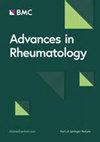Drug survival and change of disease activity using a second janus kinase inhibitor in patients with difficult-to-treat rheumatoid arthritis who failed to a janus kinase inhibitor and subsequent biologics
IF 2.1
4区 医学
Q3 RHEUMATOLOGY
引用次数: 0
Abstract
To assess the drug survival and change of disease activity using a second Janus kinase inhibitor (JAKi) after failure to a JAKi and subsequent biologic disease-modifying anti-rheumatic drugs (bDMARDs) in patients with difficult-to-treat rheumatoid arthritis (RA). This retrospective cohort study included 32 patients with difficult-to-treat RA who failed to a JAKi and subsequently to one or more bDMARDs and then switched to a second JAKi. To assess drug survival, electronic medical records of each patient were reviewed. Data on whether the second JAKi was discontinued, and the reasons for discontinuation were collected. The change of disease activity was assessed by analyzing changes in tender joint count (TJC), swollen joint count (SJC), patient’s global assessment of disease activity on a visual-analogue scale (VAS), erythrocyte sedimentation rate (ESR), C-reactive protein (CRP), Disease Activity Score for 28 joints with ESR (DAS28-ESR), and DAS28-CRP from baseline to that at six months from initiation of the second JAKi. Overall, discontinuation of the second JAKi occurred in 20 (62.5%) patients. Primary failure, secondary failure, adverse events, and insurance coverage issues were the reasons for discontinuation in 9 (45.0%), 5 (25.0%), 2 (10.0%), and 4 (20.0%) patients, respectively. The estimated 2-year drug survival rate was 39.3%. In terms of change of disease activity, the second JAKi significantly improved TJC (p < 0.001), SJC (p < 0.001), VAS (p < 0.001), CRP (p = 0.026), DAS28-ESR (p < 0.001), and DAS28-CRP (p < 0.001) at 6-month compared with that at the baseline. Second JAKi could be a therapeutic option in patients with difficult-to-treat RA who have failed to a JAKi and subsequent bDMARDs.使用第二种破伤风激酶抑制剂治疗破伤风激酶抑制剂和后续生物制剂治疗失败的难治性类风湿性关节炎患者的药物存活率和疾病活动性变化
目的:评估难治性类风湿性关节炎(RA)患者在使用一种JAKi和随后的生物改良抗风湿药(bDMARDs)失败后,使用第二种Janus激酶抑制剂(JAKi)的药物存活率和疾病活动性变化。这项回顾性队列研究纳入了32名难以治疗的类风湿性关节炎患者,他们在使用一种JAKi治疗失败后,又使用了一种或多种bDMARDs治疗,然后又改用了第二种JAKi。为了评估药物存活率,研究人员查阅了每位患者的电子病历。收集了患者是否停用第二种JAKi以及停药原因的数据。评估疾病活动性变化的方法是分析从基线到开始使用第二种JAKi后6个月期间的触痛关节数(TJC)、肿胀关节数(SJC)、患者用视觉模拟量表(VAS)对疾病活动性的总体评估、红细胞沉降率(ESR)、C反应蛋白(CRP)、有ESR的28个关节的疾病活动性评分(DAS28-ESR)和DAS28-CRP的变化。总体而言,20 例(62.5%)患者停用了第二种 JAKi。分别有9名(45.0%)、5名(25.0%)、2名(10.0%)和4名(20.0%)患者因原发性失败、继发性失败、不良事件和保险问题而停药。估计两年药物存活率为 39.3%。在疾病活动性变化方面,与基线相比,第二个JAKi在6个月时显著改善了TJC(p < 0.001)、SJC(p < 0.001)、VAS(p < 0.001)、CRP(p = 0.026)、DAS28-ESR(p < 0.001)和DAS28-CRP(p < 0.001)。对于使用JAKi和后续bDMARDs治疗失败的难治性RA患者,第二种JAKi可能是一种治疗选择。
本文章由计算机程序翻译,如有差异,请以英文原文为准。
求助全文
约1分钟内获得全文
求助全文
来源期刊

Advances in Rheumatology
Medicine-Rheumatology
CiteScore
4.00
自引率
4.30%
发文量
41
审稿时长
53 weeks
期刊介绍:
Formerly named Revista Brasileira de Reumatologia, the journal is celebrating its 60th year of publication.
Advances in Rheumatology is an international, open access journal publishing pre-clinical, translational and clinical studies on all aspects of paediatric and adult rheumatic diseases, including degenerative, inflammatory and autoimmune conditions. The journal is the official publication of the Brazilian Society of Rheumatology and welcomes original research (including systematic reviews and meta-analyses), literature reviews, guidelines and letters arising from published material.
 求助内容:
求助内容: 应助结果提醒方式:
应助结果提醒方式:


